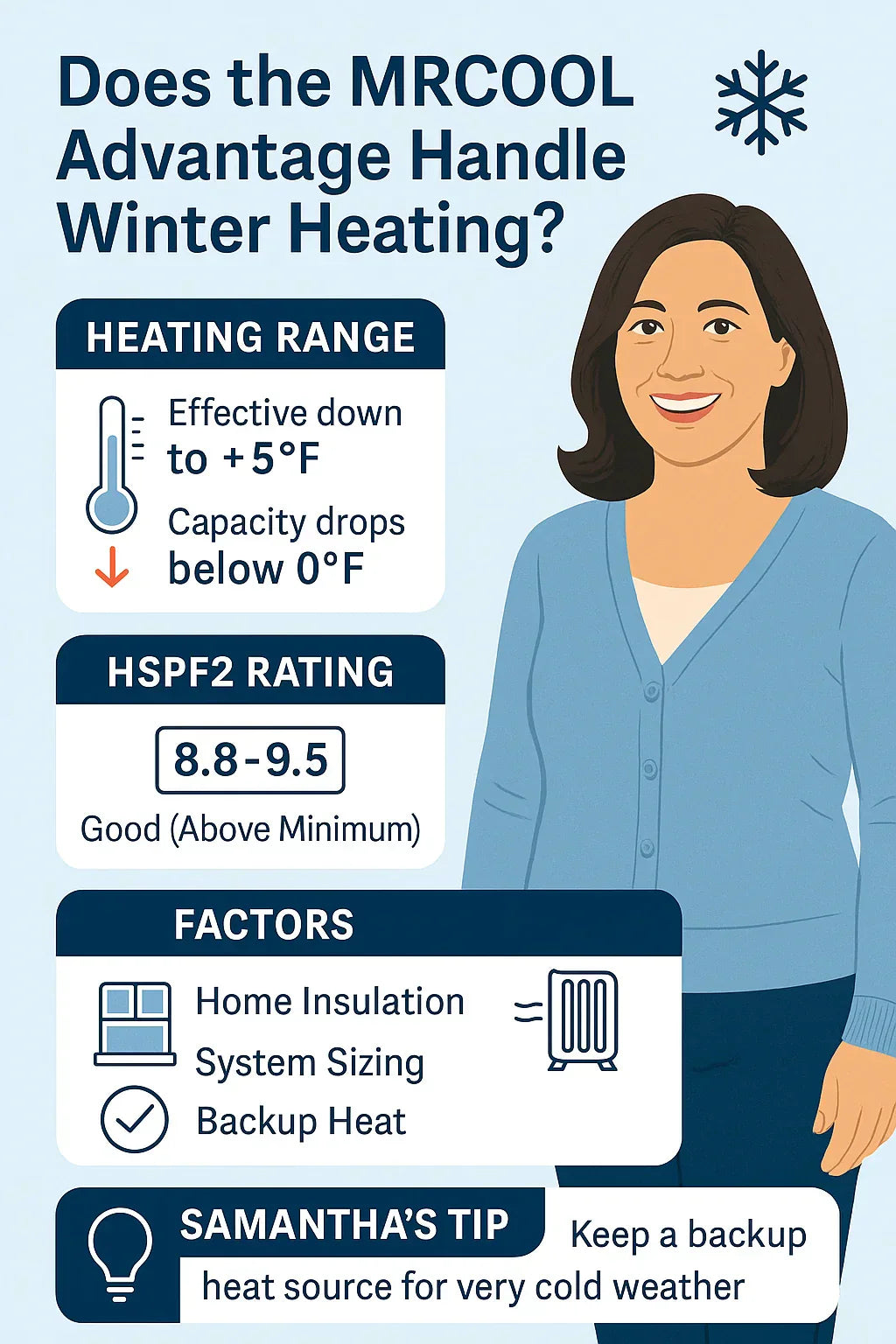Hey there—Samantha here again!
When I bought my MRCOOL Advantage 18k Mini Split, I was thrilled at how well it cooled my living room in summer. But when winter came around, one big question lingered: can a mini split like this really keep up with cold weather heating?
If you’re in a mild climate like Virginia or Tennessee, the Advantage may keep you cozy all winter long. But if you’re in Minnesota or Maine, where sub-zero temps are common, things get a little more complicated.
In this guide, we’ll explore:
-
✅ How heat pumps like the MRCOOL Advantage perform in cold climates
-
✅ The real specs (HSPF2 and operating range)
-
✅ Common winter issues and how to fix them
-
✅ When you’ll need backup heat
-
✅ My own real-world experience with cold weather heating
By the end, you’ll know whether the MRCOOL Advantage is a primary heat source for your home—or best as a supplemental system.
❄️ How Heat Pumps Work in Cold Weather
Before we dive into MRCOOL specifics, let’s talk about how heat pumps function in general.
🔄 Heat Transfer, Not Heat Creation
Unlike a furnace, which burns fuel to generate heat, a heat pump moves existing heat from outside to inside your home—even when it’s cold outdoors.
-
In summer: transfers heat from indoors → outdoors.
-
In winter: reverses the cycle → pulls heat from outdoors → indoors.
🌡 Efficiency Drops as Temps Fall
When it’s 40°F outside, there’s still plenty of heat energy in the air to transfer indoors.
When it’s 0°F outside, the pump has to work much harder, and efficiency drops significantly.
📌 Reference: Energy.gov – Heat Pump Systems
🌡 MRCOOL Advantage Heating Specs
Here’s what the Advantage line is designed for:
-
HSPF2 rating: ~8.8–9.5 (solidly above federal minimum of 7.5).
-
Effective heating range: down to ~5°F outdoor temperature.
-
Below 0°F: heating capacity begins to drop sharply.
👉 In other words, the MRCOOL Advantage will keep you warm in mild to moderately cold winters, but it isn’t a “hyper-heat” model designed for extreme cold.
📌 Reference: Energy Star – Ductless Heat Pumps
🏠 Factors That Affect Cold Climate Performance
Even with a good HSPF2 rating, your results will vary based on home conditions.
🪟 Insulation Quality
-
Well-insulated home: heat stays inside, mini split doesn’t overwork.
-
Drafty home: heat escapes quickly, requiring supplemental systems.
💡 Samantha’s Tip: I added simple weatherstripping to my windows and doors, and it made a huge difference in how my mini split performed in winter.
📌 Reference: Energy.gov – Air Sealing Your Home
📐 System Sizing
-
Correctly sized: 18k BTU covers ~700–1,000 sq ft in moderate climates.
-
Undersized: struggles to maintain setpoint in freezing weather.
-
Slightly oversized: can help offset winter losses, but beware of oversizing too much (short cycling).
📌 Reference: Senville – Mini Split Sizing Guide
🔌 Backup Heat Options
In areas where temps routinely dip below 0°F, even the Advantage’s heating ability can’t keep up. That’s when backup heat is critical.
-
Electric baseboards
-
Portable space heaters
-
Gas or propane furnaces
-
Dual-fuel hybrid setups
🧊 Common Cold Weather Issues & Fixes
Even when sized right, cold weather can cause specific problems. Here’s what to watch for:
❄️ Frost/Ice Buildup on Outdoor Unit
-
Normal in freezing temps—units enter defrost mode periodically.
-
Problem if ice builds up and stays.
Fix:
-
Keep snow cleared around condenser.
-
Ensure defrost cycle is working properly.
🌬 Reduced Airflow
-
Cause: dirty filters or blocked indoor unit.
-
Fix: clean filters every 4–6 weeks.
📌 Reference: Energy Star – Maintenance Guide
🛑 Unit Not Heating at All
-
Possible refrigerant issue.
-
Faulty sensor or compressor error.
👉 This requires a professional technician.
📌 Reference: HVAC.com – Heat Pump Cold Weather Performance
🌟 Real-World Performance
Here’s what I’ve noticed and what other homeowners report:
-
Mild climates (South, Pacific Northwest, Mid-Atlantic): The Advantage can be your primary heat source all winter.
-
Moderate climates (Midwest, Northeast): Works well most of the time, but may need a backup on the coldest nights.
-
Harsh climates (Upper Midwest, New England, Alaska): Best as a supplemental system—pair with a furnace, boiler, or wood stove.
💡 Samantha’s Story: In Virginia, my Advantage 18k kept the living/dining area perfectly warm during a 10°F cold snap. But the bedrooms further down the hall got chilly—I plugged in a space heater for my guest room, and it balanced everything out.
🏁 Conclusion
So—can the MRCOOL Advantage handle winter heating?
-
✅ Yes: For mild and moderate winters (down to ~5°F), it’s a reliable primary heating source.
-
⚠️ Maybe: In regions where temps dip below 0°F regularly, it will work—but you’ll need backup heat for the coldest days.
-
❌ Not Ideal: For extreme northern climates where winter lows hit -10°F or colder, consider a cold-climate or hyper-heat model instead.
💡 Samantha’s Advice: “Think of the Advantage as your everyday comfort partner—it does a great job most of the time. But if you live in a place where ‘polar vortex’ isn’t just a weather headline, keep a backup plan ready.”
In the next topic we will know more about: Cold Climate Performance: Does the MRCOOL Advantage Handle Winter Heating?







